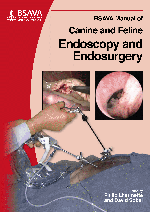
Full text loading...

PLEASE NOTE THAT A MORE RECENT EDITION OF THIS TITLE IS AVAILABLE IN THE LIBRARY
The term 'laser' is actually an acronym, standing for Light Amplification by the Stimulated Emission of Radiation. The first workable experimental laser, a pulsed ruby laser, was developed in 1960 by Theodore Maiman. A basic knowledge of optical laser physics is useful in understanding the clinical applications of laser energy. This chapter provides a brief introduction to laser physics relevant to veterinary practice. The most commonly used laser in veterinary medicine is the carbon dioxide laser. These efficient, economical and highly effective lasers are excellent for general surgical use. However, the underlying physics of these lasers means that their use in endoscopic applications is limited. This chapter discusses Instrumentation; Mass resection; and Transurethral laser lithotripsy.
An introduction to laser endosurgery, Page 1 of 1
< Previous page | Next page > /docserver/preview/fulltext/10.22233/9781905319572/9781905319572.14-1.gif

Full text loading...











